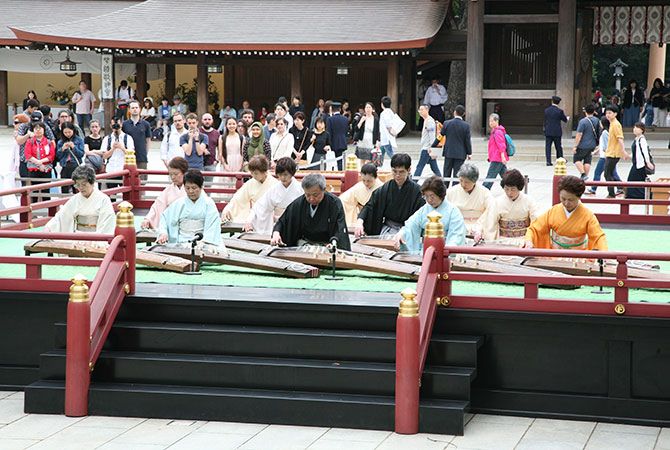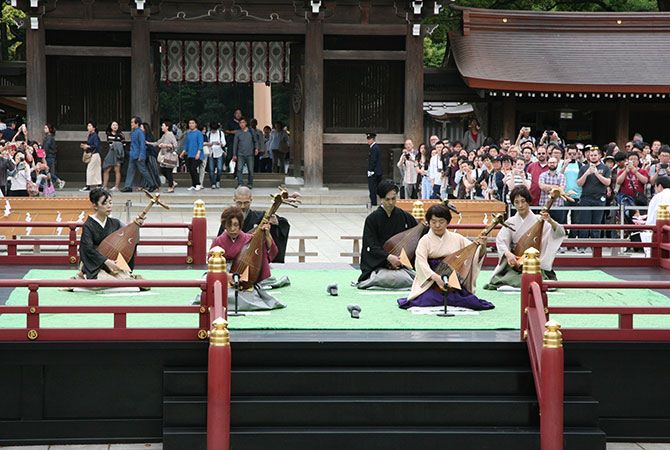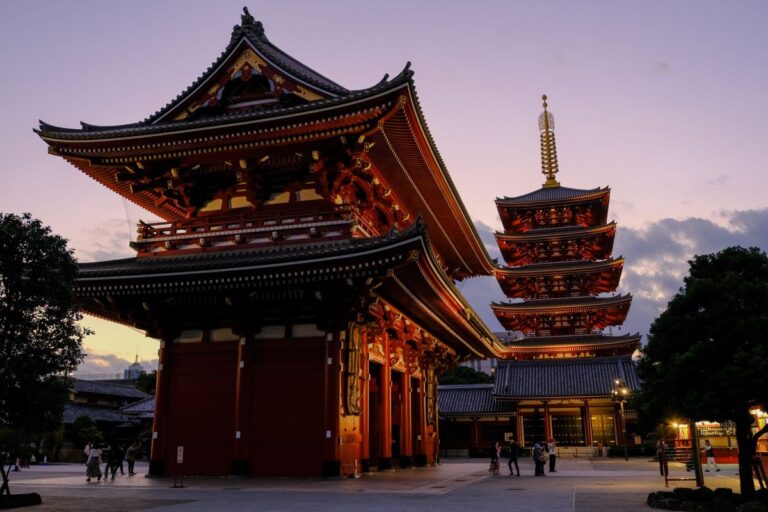The Meiji Shrine Spring Grand Festival is an annual event held in Tokyo, Japan, during the month of May. It showcases traditional Japanese culture and pays homage to Emperor Meiji and Empress Shoken.

The festival features activities such as a mikoshi parade, traditional music and dance performances, and a variety of food and drinks. Taking place at the Meiji Jingu Shrine in Shibuya City, the festival coincides with the Oedo Beer Festival, providing visitors with a blend of tradition and modernity.
Key Takeaways
- Meiji Shrine Spring Grand Festival is a popular Tokyo event in May that showcases traditional Japanese culture.
- The festival features a parade of mikoshi, traditional music, dancing, food, and drinks, and is hosted at Meiji Jingu Shrine in Shibuya City.
- The festival honors Emperor Meiji and Empress Shoken, and the dates for the 2024 festival have not been confirmed yet.
- The festival also includes traditional performances such as bugaku, noh, kyogen theater, Sankyoku chamber music, hogaku music, hobu dance, and satsuma-biwa performances, led by renowned masters in their respective fields.
What to Expect

The Meiji Shrine Spring Grand Festival offers a variety of traditional performances, such as bugaku, noh, kyogen theater, Sankyoku chamber music, and hogaku music, which showcase Japan’s rich cultural heritage and are led by renowned masters in their respective fields.
Bugaku is a traditional court dance accompanied by music and performed in colorful costumes. Noh is a classical Japanese theater form that combines music, dance, and drama. Kyogen theater is a form of comedic theater that often accompanies noh performances. Sankyoku chamber music is a traditional ensemble featuring the shamisen, koto, and shakuhachi. Hogaku music refers to traditional Japanese music performed on instruments such as the shamisen and shakuhachi.
These performances provide a unique and authentic glimpse into Japan’s artistic traditions, allowing visitors to appreciate the beauty and complexity of the country’s cultural heritage.
Performances and Music

Showcasing a variety of traditional performances and music, the Meiji Shrine Spring Grand Festival offers visitors a glimpse into Japan’s rich cultural heritage. This section explores the captivating performances that highlight Japan’s artistic traditions.
- Bugaku, Noh, and Kyogen Theater Performances: Renowned masters present these ancient art forms, showcasing the elegance, grace, and storytelling prowess of Japanese theater.
- Sankyoku Chamber Music and Hogaku Music: Enchanting melodies of traditional chamber music and hogaku captivate the audience, transporting them to a bygone era of Japan’s musical heritage.
- Hobu Dance and Satsuma-biwa Performances: These performances showcase the beauty and skill of traditional dance and music. Hobu dance mesmerizes with its graceful movements, while Satsuma-biwa, a traditional stringed instrument, evokes powerful emotions through its soulful melodies.
These performances offer a profound and immersive experience, allowing visitors to appreciate and celebrate Japan’s artistic legacy.
Exploring the Gardens
Surrounded by lush gardens, vibrant flowers, and serene natural scenery provide a picturesque backdrop for visitors attending the Meiji Shrine Spring Grand Festival. The gardens surrounding the Meiji Jingu Shrine in Tokyo are a testament to the balance between modernity and nature in the city. In springtime, these gardens come alive with blooming azaleas, Japanese Kerria, and nanja-monja, transforming into a colorful array of beauty. This natural scenery adds to the serenity and tranquility of the festival, creating a peaceful atmosphere for visitors to enjoy. The Meiji Shrine Spring Grand Festival invites people to explore the gardens and immerse themselves in the beauty of the surroundings while celebrating Japanese traditions and culture. It is a unique opportunity to witness the fusion of traditional customs with the vibrant energy of Tokyo.
Table:
| Lush Gardens | Vibrant Flowers | Serene Natural Scenery |
|---|---|---|
| Blooming Azaleas | Japanese Kerria | Nanja-monja |
| Colorful Array | Peaceful Atmosphere | Beauty of Surroundings |
| Tranquility | Balance between Modernity and Nature | Fusion of Traditional Customs |
| Serenity | Unique Opportunity | Vibrant Energy of Tokyo |
Oedo Beer Festival

Held in May like the Meiji Shrine Spring Grand Festival, the Oedo Beer Festival offers a modern alternative for visitors in Tokyo to celebrate and explore the diverse craft beer culture of Japan. This event provides a refreshing departure from the traditional festivities, showcasing Tokyo’s vibrant and evolving social scene.
The Oedo Beer Festival features a wide selection of craft beers from both local and international breweries, allowing attendees to indulge in a variety of flavors and styles. With its lively atmosphere and diverse range of offerings, this event appeals to those seeking a more contemporary experience while still celebrating Japanese culture.
Whether it’s discovering new flavors, socializing with friends, or simply enjoying the lively ambiance, the Oedo Beer Festival offers a unique and enjoyable experience for beer enthusiasts and festival-goers alike.
Frequently Asked Questions
How long has the Meiji Shrine Spring Grand Festival been celebrated?
The Meiji Shrine Spring Grand Festival has been celebrated for an undisclosed number of years. The festival is a popular Tokyo event that showcases traditional Japanese culture and honors Emperor Meiji and Empress Shoken.
What is the significance of the mikoshi parade in the festival?
The mikoshi parade in the Meiji Shrine Spring Grand Festival holds great significance as it symbolizes the transport of deities’ spirits. This vibrant procession reflects the deep reverence for Japanese traditions and attracts crowds of spectators.
Are there any specific rules or etiquette that visitors should follow during the festival?
Visitors to the Meiji Shrine Spring Festival should be mindful of the following rules and etiquette: dress respectfully, remove shoes before entering certain areas, refrain from touching or entering restricted areas, and be mindful of noise levels and litter.
Can visitors participate in any of the traditional performances or music?
Visitors to the Meiji Shrine Spring Festival can participate in traditional performances and music. Renowned masters lead bugaku, noh, kyogen theater, sankyoku chamber music, hogaku music, hobu dance, and satsuma-biwa performances, showcasing Japan’s rich cultural heritage.
Is there an admission fee to enter the Meiji Jingu Shrine during the festival?
There is no admission fee to enter the Meiji Jingu Shrine during the festival. Visitors are invited to participate in the week-long celebration without any charge, allowing everyone to experience the rich traditions and cultural heritage showcased at the event.
The Sum Up
To sum it up, the Meiji Shrine Spring Grand Festival in Tokyo, Japan is a vibrant celebration that showcases the rich tradition and culture of the country.
With its array of activities, including the Mikoshi Parade, traditional music and dance performances, and the Oedo Beer Festival, the festival offers visitors a unique blend of traditional festivities and modern experiences.
Surrounded by lush gardens, the festival creates a colorful spectacle during springtime and provides a captivating atmosphere.
The Meiji Shrine Spring Grand Festival is a must-visit event for anyone seeking to immerse themselves in Japanese heritage and witness the deep reverence for tradition and culture.



